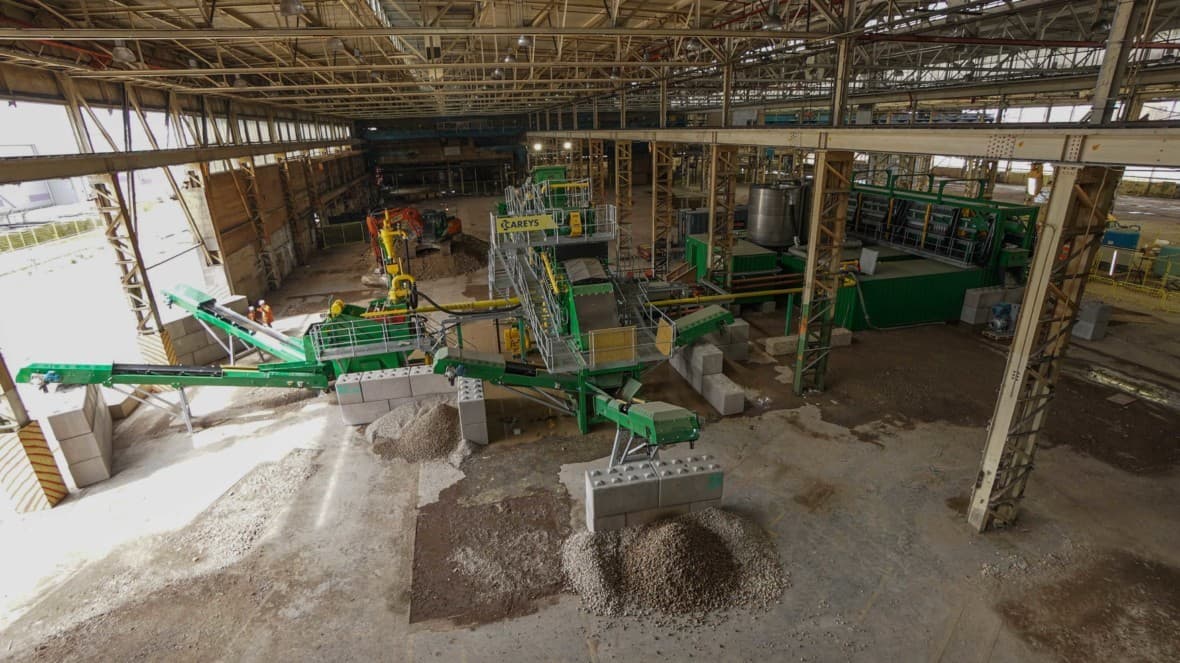Building our Self-Delivery Capability: Soil Engineering Plant

Carey Group’s new Soil Engineering Plant represents a true Group achievement, being made possible through the investment of Careys Plant & Fleet. The Plant is operated under the Seneca Resource Recovery permit, deployed on the Scudder Demolition Ford Dagenham site and managed by the Carey Group materials manager. The plant is capable of remediating all types of material excavated by Careys Civil Engineering.
- The Carey Group
- Friday 4th May 2018
Share this:-
Constructed by McCloskey Washing Systems, the state-of-the-art Aggstorm 60 is an impressive feat of modern engineering. Capable of processing 500-750t per day depending on material type, the investment reflects the Group’s overall strategy of self-delivery and will provide recovered aggregates for the Ford Dagenham development and other Carey Group projects.
The plant provides an extensive platform for cleaning, remediating and segregating coarse and fine aggregates extracted from construction and demolition waste. It also provides environmentally sustainable water treatment within this process. This new capability supports the Group’s progress in remediating contaminated sites. Careys has invested in an on-site laboratory to enable same-day testing of heavy metals and hydrocarbons, assisting in the identification of required treatment measures. The laboratory can also issue test certificates to confirm the usability of the remediated material, providing projects with a complete remediation solution.
“The plan is eventually to have the machine support our excavations across London and the South of England,” says Gary Condon, Managing Director of Careys Plant & Fleet, “Usually, we’d transport excavated material to specialists for processing, but this machine enables us to do it ourselves, creating big benefits in reducing transport and processing costs for our clients. It’s the equivalent of removing dozens of trucks from the roads every day - great for both project efficiency and the environment.”
As we talk, material is being poured into the machine hopper, passing through a metal grille which separates elements measuring more than 50mm from the main stream. As it comes out of the hopper, Gary points to a large metal box which is extracting metals from the material downstream.
“This overband magnet is a good example of the modular nature of the equipment. Every element of the machine is designed to extract a different type or size of material with numerous customisation options to improve performance.”
As we watch, the remainder of the material is transported along the inclined conveyor and into the 'log wash’ which sprays the material stream with high pressure water to separate sand, clay and silt from the usable aggregate material. The coarse material then passes over plate screens to separate varying sizes of coarse aggregates including 40mm and 20mm, with the remaining silty water being piped into the twin cyclonic filter system, which separates two sand fractions, coarse and building sand from the clay and silt. The clay and silt which is suspended in the water is then pumped to the press system.
“By this point, the usable aggregate material has been completely segregated by size, leaving dirty water for remediation” says Gary. “This is piped into a hydraulic press system of concertina filter plates where it is compressed to separate any water from the solid material. This produces compressed ‘filter cakes’ which can be used as either a fill material or further remediated as required”.
Any water used or extracted during the process is fed through a water treatment plant to remove contamination through the use of oil skimmers, sand and carbon filters before re-entering the wash plant water tanks. Any excess water extracted during the process is used for dust suppression on-site, with surface water from site being harvested to top up the system, creating a sustainable alternative to using mains water.
The plant has achieved Environment Agency approval to remediate material up to a ‘hazardous’ classification to produce aggregates and soils for reuse and demonstrates the Group’s continued investment in specialist, innovative equipment and our drive to undertake self-delivery of innovative solutions for our clients.
We'd love to hear from you, so please get in touch